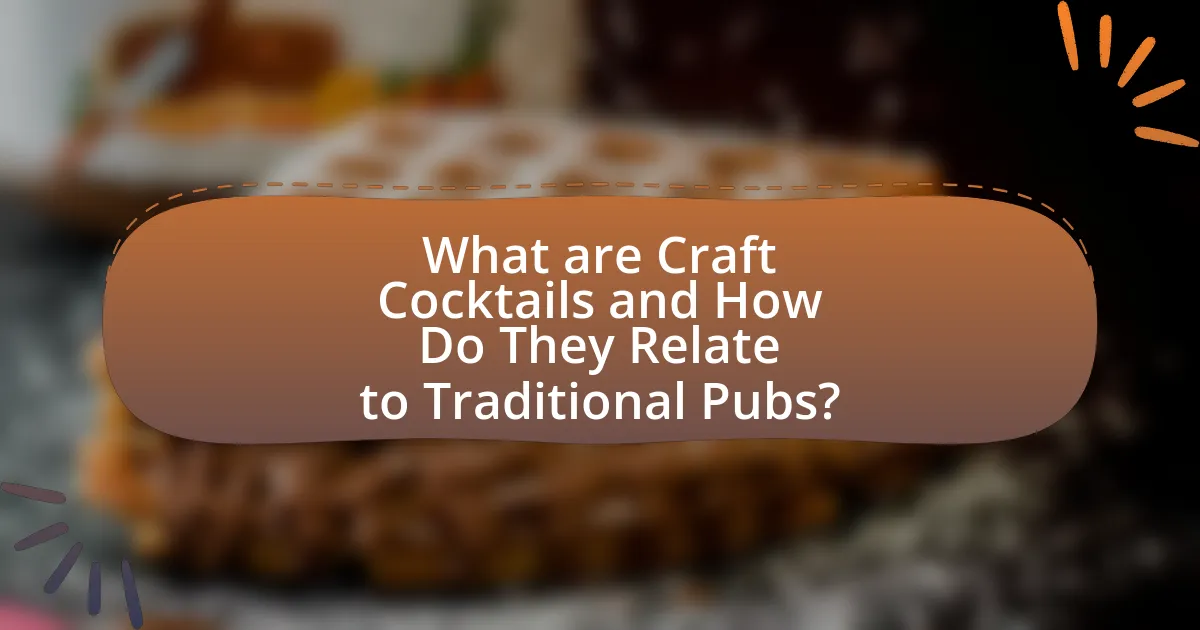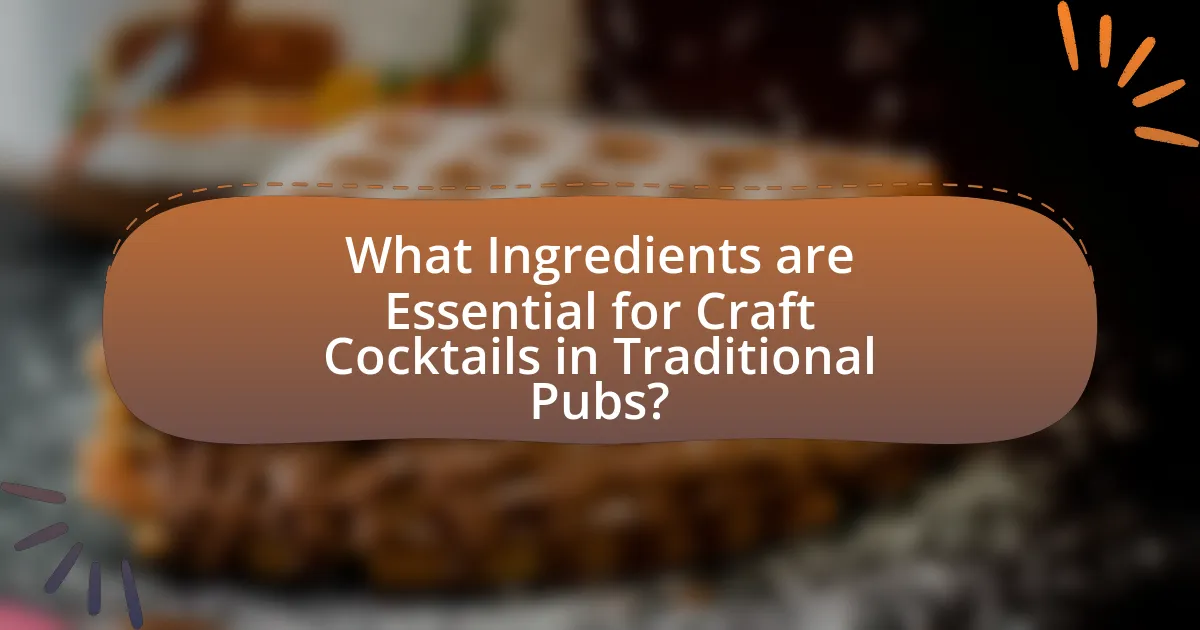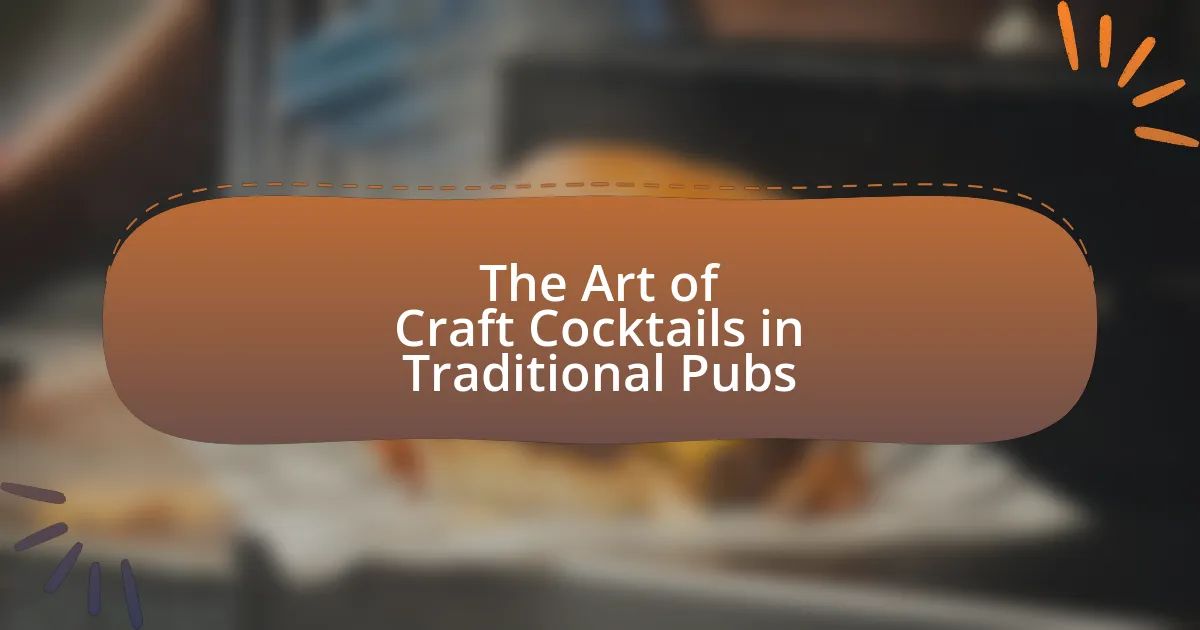The article explores the integration of craft cocktails into traditional pubs, highlighting the meticulous preparation and high-quality ingredients that define these beverages. It examines how traditional pubs are adapting to modern consumer preferences by incorporating innovative cocktail offerings while maintaining their historical charm. Key topics include the distinction between craft and standard cocktails, the significance of local and seasonal ingredients, essential techniques for cocktail crafting, and best practices for serving these drinks in a pub setting. Additionally, the article addresses the cultural importance of traditional pubs in the craft cocktail movement and the challenges they face in this evolving landscape.

What are Craft Cocktails and How Do They Relate to Traditional Pubs?
Craft cocktails are meticulously crafted drinks that emphasize high-quality ingredients, innovative techniques, and unique flavor combinations. They relate to traditional pubs by enhancing the drinking experience, as many pubs have begun to incorporate craft cocktails into their menus to attract a broader clientele and elevate their beverage offerings. This shift reflects a growing trend where traditional establishments adapt to modern tastes while maintaining their classic charm, thus bridging the gap between historical pub culture and contemporary mixology.
How are craft cocktails defined in the context of traditional pubs?
Craft cocktails in the context of traditional pubs are defined as meticulously crafted drinks that emphasize quality ingredients, innovative techniques, and unique flavor profiles. These cocktails often incorporate fresh, locally sourced ingredients and artisanal spirits, distinguishing them from standard pub offerings. The rise of craft cocktails in traditional pubs reflects a broader trend towards mixology as an art form, where bartenders apply culinary skills to create distinctive beverages that enhance the overall pub experience.
What distinguishes craft cocktails from standard cocktails?
Craft cocktails are distinguished from standard cocktails primarily by their emphasis on high-quality, fresh ingredients and meticulous preparation techniques. Craft cocktails often utilize artisanal spirits, house-made syrups, and fresh herbs or fruits, which enhance flavor complexity and overall quality. In contrast, standard cocktails typically rely on mass-produced mixers and pre-made ingredients, resulting in a less nuanced taste profile. The craft cocktail movement has gained traction since the early 2000s, reflecting a broader trend towards culinary innovation and a focus on the craft of mixology, as evidenced by the rise of specialized bars and cocktail competitions that prioritize creativity and skill.
Why are traditional pubs embracing craft cocktails?
Traditional pubs are embracing craft cocktails to attract a broader clientele and enhance their beverage offerings. This shift is driven by changing consumer preferences, as patrons increasingly seek unique and high-quality drinking experiences. According to a 2022 report by the Distilled Spirits Council, the craft cocktail market has seen a growth rate of 20% annually, indicating a rising demand for innovative drinks. By incorporating craft cocktails, traditional pubs can differentiate themselves from competitors, increase customer satisfaction, and boost overall sales.
What role do traditional pubs play in the craft cocktail movement?
Traditional pubs serve as vital venues for the craft cocktail movement by providing a social atmosphere that encourages experimentation and community engagement. These establishments often blend classic pub culture with innovative cocktail offerings, allowing bartenders to showcase their creativity while honoring traditional drink-making techniques. For instance, many traditional pubs have begun to incorporate locally sourced ingredients and artisanal spirits into their cocktail menus, reflecting a growing trend towards sustainability and authenticity in the beverage industry. This shift not only attracts a diverse clientele but also fosters a deeper appreciation for craft cocktails among patrons who may have previously favored standard pub drinks.
How do traditional pubs maintain their identity while serving craft cocktails?
Traditional pubs maintain their identity while serving craft cocktails by integrating these modern beverages into their established atmosphere and culture. They achieve this by using locally sourced ingredients and traditional recipes that reflect the pub’s heritage, ensuring that the craft cocktails resonate with the local community. For instance, many traditional pubs incorporate regional spirits and flavors into their cocktail offerings, which helps to preserve their unique character while appealing to contemporary tastes. This approach not only honors the pub’s history but also attracts a diverse clientele, blending the old with the new in a way that enhances the overall experience without compromising the pub’s traditional identity.
What cultural significance do traditional pubs have in cocktail crafting?
Traditional pubs hold significant cultural importance in cocktail crafting as they serve as communal spaces where social interaction and the sharing of drink traditions occur. These establishments often reflect local history and customs, influencing the ingredients and techniques used in cocktail creation. For instance, many classic cocktails have origins tied to specific regions or local ingredients, showcasing the unique flavors of the area. Additionally, traditional pubs often emphasize craftsmanship and quality, encouraging bartenders to innovate while respecting historical recipes. This blend of community, history, and craftsmanship fosters a rich environment for cocktail culture, making traditional pubs vital to the evolution of cocktail crafting.

What Ingredients are Essential for Craft Cocktails in Traditional Pubs?
Essential ingredients for craft cocktails in traditional pubs include high-quality spirits, fresh citrus, bitters, and artisanal mixers. High-quality spirits, such as gin, whiskey, and rum, form the base of many cocktails, providing distinct flavors. Fresh citrus, like lemons and limes, adds acidity and brightness, essential for balancing flavors. Bitters, which are concentrated flavor extracts, enhance complexity and depth in cocktails. Artisanal mixers, including tonic water and soda, elevate the overall drinking experience by offering unique flavor profiles. These ingredients are foundational in creating well-crafted cocktails that reflect the artistry of traditional pub culture.
What types of spirits are commonly used in craft cocktails?
Craft cocktails commonly utilize spirits such as gin, vodka, rum, whiskey, tequila, and brandy. These spirits serve as the foundational elements in various cocktail recipes, each contributing distinct flavors and characteristics. For instance, gin is often favored for its botanical notes, while whiskey provides depth and complexity. Vodka is known for its versatility, allowing it to blend seamlessly with other ingredients. Rum, particularly in its aged form, adds sweetness and richness, while tequila brings a unique agave flavor. Brandy, often used in classic cocktails, offers a smooth and fruity profile. The selection of these spirits is essential in crafting balanced and innovative cocktails, reflecting the artistry involved in traditional pub settings.
How do different spirits influence the flavor profile of cocktails?
Different spirits significantly influence the flavor profile of cocktails by imparting unique characteristics based on their ingredients, production methods, and aging processes. For example, vodka is known for its neutral flavor, allowing other ingredients to shine, while gin adds herbal and botanical notes due to its juniper and other botanicals. Whiskey contributes rich, complex flavors, often with notes of caramel, vanilla, and oak, depending on its aging process. Rum can introduce sweetness and tropical flavors, particularly if it is made from molasses or sugarcane. Each spirit’s distinct flavor compounds interact with mixers and garnishes, creating a diverse range of taste experiences in cocktails. This interaction is supported by the principles of flavor pairing, which highlight how different taste profiles can complement or contrast with one another, enhancing the overall drinking experience.
What are the best mixers and garnishes for craft cocktails?
The best mixers for craft cocktails include tonic water, soda water, fresh juices, and flavored syrups, while the top garnishes consist of citrus peels, herbs, and edible flowers. Tonic water enhances the flavor of spirits like gin, while soda water adds effervescence to cocktails. Fresh juices, such as lime or orange, provide acidity and balance, and flavored syrups can introduce sweetness and complexity. Garnishes like citrus peels add aroma and visual appeal, herbs like mint or basil contribute freshness, and edible flowers can elevate presentation. These elements are essential in creating well-balanced and visually appealing craft cocktails, as they enhance both flavor and aesthetic.
How do local ingredients enhance craft cocktails in traditional pubs?
Local ingredients enhance craft cocktails in traditional pubs by providing unique flavors that reflect the region’s culture and agricultural heritage. Utilizing locally sourced fruits, herbs, and spirits allows bartenders to create distinctive cocktails that resonate with the local community. For instance, a pub in the Pacific Northwest might incorporate locally grown berries and artisanal spirits, resulting in cocktails that not only taste fresh but also tell a story about the area’s landscape and farming practices. This connection to local agriculture fosters a sense of authenticity and supports local economies, making the drinking experience more meaningful for patrons.
What are the benefits of using locally sourced ingredients?
Using locally sourced ingredients enhances the quality and flavor of craft cocktails in traditional pubs. Freshness is a key benefit, as locally sourced ingredients are often harvested at peak ripeness, resulting in superior taste compared to those transported over long distances. Additionally, supporting local farmers and producers fosters community relationships and boosts the local economy. According to a study by the USDA, local food systems can increase economic activity by up to 13 times compared to conventional food systems. Furthermore, using seasonal ingredients allows for a dynamic cocktail menu that reflects the local terroir, providing patrons with a unique and authentic drinking experience.
How can traditional pubs incorporate seasonal ingredients into their cocktail menus?
Traditional pubs can incorporate seasonal ingredients into their cocktail menus by sourcing local produce that reflects the current season, such as fresh fruits, herbs, and spices. For example, during spring, pubs can use ingredients like rhubarb and elderflower, while in autumn, they can feature apples and cinnamon. This approach not only enhances the flavor profile of cocktails but also supports local agriculture and reduces carbon footprint. Research indicates that using seasonal ingredients can increase customer interest and satisfaction, as patrons often seek unique and fresh experiences in their dining choices.

What Techniques are Used to Create Craft Cocktails in Traditional Pubs?
Craft cocktails in traditional pubs are created using techniques such as muddling, shaking, stirring, and layering. Muddling involves crushing ingredients like herbs or fruits to release their flavors, while shaking combines ingredients with ice to chill and dilute the drink effectively. Stirring is used for cocktails that require a smoother texture, allowing for gentle mixing without excessive aeration. Layering involves carefully pouring liquids of different densities to create visually appealing drinks. These techniques are essential for enhancing flavor profiles and presentation, which are crucial in the craft cocktail movement.
What are the essential techniques for crafting cocktails?
The essential techniques for crafting cocktails include shaking, stirring, muddling, layering, and garnishing. Shaking combines ingredients with ice to chill and aerate the drink, while stirring gently mixes ingredients without excessive dilution. Muddling involves crushing ingredients like herbs or fruits to release their flavors. Layering creates visually appealing drinks by carefully pouring liquids of different densities. Finally, garnishing enhances presentation and adds aroma, often using fruits, herbs, or spices. These techniques are foundational in mixology, ensuring balanced flavors and appealing aesthetics in cocktails.
How does shaking differ from stirring in cocktail preparation?
Shaking and stirring are two distinct methods of cocktail preparation that affect the drink’s texture and temperature. Shaking involves combining ingredients in a shaker with ice, resulting in a colder, more diluted cocktail with a frothy texture due to aeration. In contrast, stirring gently mixes ingredients in a mixing glass with ice, producing a smoother, less diluted drink that maintains clarity and a silkier mouthfeel. The choice between shaking and stirring often depends on the ingredients used; for example, cocktails containing fruit juices or egg whites are typically shaken, while spirit-forward drinks like martinis are stirred to preserve their integrity.
What role does presentation play in craft cocktails?
Presentation plays a crucial role in craft cocktails by enhancing the overall drinking experience and influencing customer perception. A well-presented cocktail not only attracts attention but also communicates the quality and creativity of the drink, which can elevate the perceived value. Research indicates that visual appeal significantly impacts taste perception; for instance, a study published in the journal “Food Quality and Preference” found that participants rated the taste of drinks higher when they were presented attractively. This demonstrates that presentation is not merely aesthetic but also affects the sensory experience of the cocktail.
How can bartenders master the art of cocktail crafting?
Bartenders can master the art of cocktail crafting by developing a deep understanding of ingredients, techniques, and presentation. Mastery involves studying the flavor profiles of various spirits, mixers, and garnishes, allowing bartenders to create balanced and innovative cocktails. Techniques such as shaking, stirring, muddling, and layering are essential skills that bartenders must practice to achieve the desired texture and flavor in their drinks.
Furthermore, knowledge of classic cocktail recipes serves as a foundation for creativity, enabling bartenders to experiment and create unique variations. Engaging in continuous education through workshops, tastings, and industry events enhances their skills and keeps them updated on trends. According to the United States Bartenders’ Guild, ongoing training and practice are crucial for achieving proficiency in cocktail crafting, as they emphasize the importance of both technical skills and creativity in the bartending profession.
What training or resources are available for aspiring bartenders?
Aspiring bartenders can access various training programs and resources, including bartending schools, online courses, and industry certifications. Bartending schools, such as the New York Bartending School, offer hands-on training and curriculum covering mixology, customer service, and bar management. Online platforms like Udemy and Coursera provide flexible courses on cocktail preparation and bartending skills, allowing learners to study at their own pace. Additionally, certifications from organizations like the United States Bartenders’ Guild (USBG) enhance credibility and knowledge in the field. These resources collectively equip aspiring bartenders with essential skills and industry knowledge necessary for success.
How can bartenders develop their unique cocktail recipes?
Bartenders can develop their unique cocktail recipes by experimenting with various ingredients, techniques, and flavor profiles. This process involves understanding the balance of flavors, such as sweet, sour, bitter, and umami, and how they interact with each other. For instance, bartenders can start by selecting a base spirit and then incorporating complementary flavors through fresh herbs, fruits, or spices. Additionally, they can draw inspiration from classic cocktails, modifying them to create something new while maintaining the essence of the original.
Research indicates that creativity in mixology often stems from a combination of knowledge and experimentation; a study published in the Journal of Culinary Science & Technology highlights that successful cocktail innovation frequently involves trial and error, allowing bartenders to refine their recipes based on taste tests and customer feedback. This iterative process not only enhances the bartender’s skills but also leads to the creation of distinctive cocktails that reflect their personal style and the ambiance of the pub.
What are the Best Practices for Serving Craft Cocktails in Traditional Pubs?
The best practices for serving craft cocktails in traditional pubs include using high-quality ingredients, ensuring proper glassware, and training staff on cocktail preparation and presentation. High-quality ingredients enhance flavor and authenticity, while appropriate glassware elevates the drinking experience. Staff training is crucial, as knowledgeable bartenders can engage customers and provide recommendations, which increases customer satisfaction and sales. According to a study by the Distilled Spirits Council, establishments that focus on craft cocktails see a 20% increase in customer retention, highlighting the importance of these practices in driving business success.
How can traditional pubs create an inviting atmosphere for cocktail enthusiasts?
Traditional pubs can create an inviting atmosphere for cocktail enthusiasts by incorporating a diverse cocktail menu, skilled bartenders, and a comfortable ambiance. A diverse cocktail menu showcases unique and classic cocktails, appealing to various tastes and preferences, which can attract cocktail enthusiasts. Skilled bartenders enhance the experience by demonstrating expertise in mixology, engaging customers with their knowledge, and offering personalized recommendations. Additionally, a comfortable ambiance, characterized by warm lighting, cozy seating, and tasteful decor, encourages patrons to relax and enjoy their drinks, fostering a welcoming environment. These elements collectively contribute to an inviting atmosphere that appeals specifically to cocktail lovers.
What are the common challenges faced when serving craft cocktails in traditional pubs?
Common challenges faced when serving craft cocktails in traditional pubs include limited space for equipment, lack of trained staff, and insufficient inventory of specialized ingredients. Traditional pubs often have a focus on beer and simple drinks, which can hinder the ability to create complex cocktails that require specific tools and techniques. Additionally, staff may not have the necessary training in mixology, leading to inconsistent drink quality. Furthermore, the limited availability of fresh herbs, unique spirits, and other cocktail components can restrict the menu options, making it difficult to meet customer expectations for craft cocktails.
